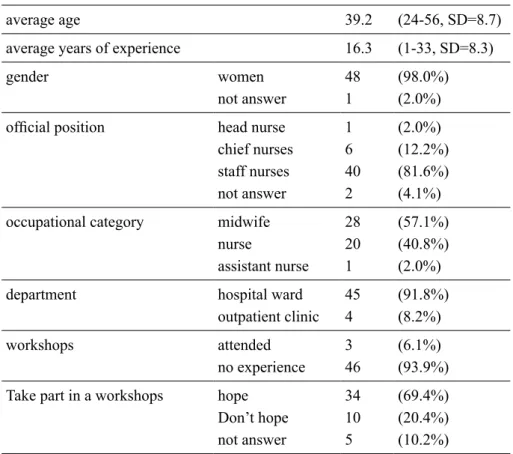Abstract
The purpose of the present study was to clarify the actual condition of post-miscarriage care provided by midwifery staffs and to define its problems and future tasks. The study involved 65 nurses and midwives working in obstetrics and gynecology wards and outpatient clinics of some hospitals in Japan. The responses were obtained from 49. The age of the subjects ranged from 24 to 56 years with the average of 39.2 years (SD = 8.7). The subjects were asked to rate 23 items of post-miscarriage care. The following items of care were performed at a high frequency: “not to blame the patient for the miscarriage”; “provide treatment when the patient is physically exhausted”; “provide treatment for pain”; etc. The following items of care were performed at a low frequency: “continuously provide care via the telephone and at the outpatient clinic”; “provide information on support groups, etc.,” “support the patient’s husband and family,” etc. Many midwifery staffs working in obstetrics and gynecology departments and outpatient clinics had experienced care for women after miscarriage, but their satisfaction with the care they could provide was low. Physical care and care not to blame the patient for the miscarriage were provided at a high frequency, whereas telephone counseling, continuous care, provision
of information on the cause of miscarriage, lost fetus and next pregnancy, support groups, care for the patient’s husband and family, care to encourage expression of feelings and care to make the patient feel at ease without having to consider the feelings of other people were performed at a low frequency.
Introduction
In 2009, the number of births in Japan was approximately 1,070,000, whereas the numbers of stillbirths and induced abortions were approximately 27,000 and 240,000, respectively.
Based on these figures, it is clear that many women and their families experience the loss of a fetus or infant in the perinatal period. Pregnancy/
childbirth is one of the most important experiences in the life events of any women, and in cases of miscarriage and stillbirth, such women are strongly affected physically, psychologically and socially.
It has recently been revealed that the death of a fetus/infant in the perinatal period causes a grief reaction in parents, particularly mothers, so that they undergo a grieving process [1,2]. In addition, it has been reported that parents undergo a mental process specific to spontaneous or induced abortion and that they experience aggressive feelings such as anger, distrust and blame as well
A study on the actual nursing care conditions for women after miscarriage and the satisfaction of midwifery staffs with care provided
Yasuko Tsukamoto
1, Hiroko Shimoyama
1, Noriko Yamaguchi
1, Akemi Masuda
21
Department of Nursing, Niigata University of Health and Welfare, Niigata, Japan
2

